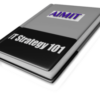This consultant profile optimization playbook covers the essential steps every consultant needs to attract clients, showcase expertise, and drive business results. From crafting a compelling bio to leveraging social proof, you’ll learn how to build a digital presence that wins over decision-makers before any face-to-face meeting.
1. Introduction
1.1 Importance of First Impressions
In a digitally driven world, prospective clients often form an opinion about you before you ever meet them in person. They do this by quickly scanning online profiles to see if your expertise resonates with their needs. For consultants looking to work with CIOs, this virtual “first impression” can be pivotal—it can either pique a CIO’s interest enough to prompt direct outreach or cause them to move on to someone else’s profile.
Moreover, the fast pace of decision-making in executive circles leaves little room for a lackluster online presence. By the time a CIO reaches out, they’ve typically done preliminary research to gauge your credibility, track record, and approach. Ensuring your profile communicates a strong, focused narrative immediately sets a positive tone for any future discussion or proposal.
1.2 Why a Well-Structured Consultant Profile Matters
Your online profile is more than just a digital résumé—it’s a personal brand statement that speaks to your unique skill set, values, and professional identity. When carefully crafted, it not only conveys what you do but also why you do it, highlighting the passion and purpose behind your consulting work.
A polished profile projects trustworthiness and competence. CIOs are more likely to engage with consultants who present a compelling blend of technical acumen and strategic insight. By structuring your bio, expertise, and endorsements in a way that aligns with CIO concerns—such as risk management, cost optimization, or digital transformation—you reinforce your status as a credible authority. The end result is a strong, consistent message that quickly conveys you are the right person to tackle pressing IT challenges.
1.3 The CIO Index Advantage
Standing out on a crowded digital stage can be challenging, which is why CIO Index’s platform is uniquely designed to help consultants shine in front of senior IT leaders. By hosting your profile on CIO Index, you position yourself within a curated community where CIOs specifically look for expertise, insights, and partnerships. This targeted environment increases the likelihood of meaningful engagement from decision-makers.
CIO Index also provides easy-to-use tools that simplify the process of creating and maintaining a compelling profile. From clear prompts for highlighting your core competencies to features that showcase testimonials and thought leadership, the platform ensures your most relevant accomplishments and expertise are front and center. By leveraging these built-in advantages, you can quickly capture a CIO’s attention—and keep it—before that all-important first meeting even takes place.
2. Laying the Foundation: Profile Fundamentals
2.1 Consistency and Clarity
When a CIO visits your profile, clarity should be the first thing that stands out. Use the same name, title, and professional tagline across all sections to avoid confusion. Make sure each section—whether it’s your bio, summary of services, or contact details—aligns with your core messaging.
- Present a Cohesive, Professional Image: If you introduce yourself as “IT Strategy Consultant” in your headline, reinforce that descriptor everywhere else. Avoid creating disjointed impressions or uncertainty around what you do.
- Keep Content Updated: Outdated or contradictory information can undermine your credibility. Regularly review your profile to ensure past roles, skills, or achievements accurately reflect your current level of expertise.
Staying consistent in both language and design elements (such as formatting or branding colors) helps you come across as polished and detail-oriented. This steady, unified approach builds trust: it shows you practice the same rigor you’d bring to a client’s project.
2.2 Professional Tone and Language
Your profile tone should strike a balance between being approachable and authoritative. CIOs are used to technical jargon and industry buzzwords, but remember they are also busy executives who want to get information quickly and clearly.
- Approachable Yet Credible: Use an inviting tone that conveys your willingness to collaborate, while also highlighting your expertise. For instance, phrases like “I help CIOs drive cost savings through cloud optimization” are straightforward yet demonstrate confidence.
- Appropriate Use of Jargon: Incorporate relevant industry terms to show your subject-matter expertise, but avoid lengthy technical explanations that might overwhelm the reader. A concise approach ensures CIOs can quickly see how your skills align with their needs.
By staying professional yet direct, you demonstrate that you understand the CIO’s perspective: you speak their language but respect their limited time. This accessible tone can be the deciding factor in whether they reach out to learn more.
2.3 Establishing Your Value Proposition
A core element of a strong profile is a clear value proposition. This not only defines what you do, but also the meaningful outcome of working with you.
- Articulate Your Offering and Its Significance: Explain the unique services, solutions, or guidance you provide, and why they matter. For example, if you specialize in digital transformation for mid-market firms, emphasize how this expertise leads to measurable efficiency gains or competitive advantages.
- Align With CIO Challenges: Pinpoint and address the key concerns CIOs typically wrestle with—ranging from cybersecurity threats to large-scale IT overhauls. Present your solutions as direct answers to these challenges.
When your profile speaks directly to the problems CIOs face, you position yourself as a relevant, impactful resource. A well-defined value proposition gives them a reason to believe you can help elevate their IT operations, reduce risk, or spur innovation—benefits that resonate far beyond a simple list of credentials.
3. Crafting an Engaging Bio
3.1 Telling Your Story
Your bio is more than a summary of your qualifications—it’s an opportunity to connect with CIOs on a human level. Share the personal anecdotes or career experiences that led you to consulting, such as a pivotal project or a passion for solving IT challenges.
- Personal Anecdotes: If you once spearheaded a risky cloud migration that ended up saving your organization 40% in operational costs, mention it briefly. A good story sparks interest and lends authenticity.
- Demonstrating Passion and Expertise: Don’t hesitate to highlight your enthusiasm for your field—whether it’s digital transformation or data security. Passion, when combined with real-world experience, sets you apart from those who rely solely on buzzwords.
Your story should convey not just what you do, but why you do it. This personal dimension builds trust and makes a CIO more likely to remember you among other potential consultants.
3.2 Highlighting Achievements and Credentials
While narrative elements can humanize your profile, concrete accomplishments showcase your proven track record. By framing your successes in terms of quantifiable outcomes, you help CIOs quickly envision the value you can bring.
- Key Projects and Awards: Mention high-profile initiatives or certifications that validate your expertise. For instance, referencing industry accreditations (e.g., PMP, CISSP) or notable awards (e.g., “Top Consultant of the Year”) can establish immediate credibility.
- Return on Investment (ROI) Emphasis: Whenever possible, include metrics—like percentage increases in efficiency, budget savings, or revenue growth—to translate abstract skills into tangible results.
This combination of accolades and real-world impact signals that you have a history of delivering measurable benefits, reinforcing that you’re equipped to handle the challenges CIOs face daily.
3.3 Aligning With Client Needs
Ultimately, your bio should speak directly to the priorities and pain points of CIOs, from cybersecurity and compliance demands to digital transformation initiatives.
- Relevance to CIO Challenges: Connect your background to the technical and strategic hurdles CIOs typically wrestle with. This might involve mentioning how your leadership on a past IT overhaul solved a legacy system issue or accelerated go-to-market plans.
- Empathy and Readiness: Show you understand their perspective and are prepared to address specific needs—highlighting both your expertise and your problem-solving approach.
By weaving your expertise and achievements into a narrative that resonates with CIO concerns, you position yourself as more than just a service provider. You become a trusted advisor who is ready to tackle complex problems with knowledge, empathy, and proven results.
4. Showcasing Expertise and Services
4.1 Structuring Your Expertise
When CIOs browse consultant profiles, they’re looking for quick confirmation of your capability areas. By grouping your core competencies into distinct categories—such as Cloud Strategy, Cybersecurity, or IT Governance—you make it easy for decision-makers to see whether your skill set aligns with their requirements.
- Clear, Defined Categories: Ensure each category has a concise title and a brief description. This approach helps CIOs quickly scan your profile for relevant expertise.
- Relevant Keywords: Incorporate terms that match trending industry topics and pressing CIO concerns (e.g., “zero-trust security,” “digital transformation roadmap,” “Agile development”). The right keywords boost discoverability and assure potential clients you’re up-to-date.
Organizing your expertise into logical groups not only clarifies what you do but also underscores your focus on solving specific IT and business challenges.
4.2 Presenting Concrete Service Offerings
Beyond skill sets, CIOs want to know how you apply your expertise in practical, results-oriented ways. Listing your services in a straightforward manner helps them grasp your capabilities without wading through fluff.
- Straightforward Service Listings: Use simple headings like “Cloud Migration Consulting,” “Cybersecurity Assessment,” or “IT Strategy Roadmap Development.” Provide a short, bullet-point explanation under each.
- Context and Outcomes: Whenever possible, mention the benefits of each service (e.g., “reducing operational costs by up to 30%,” “improving compliance readiness,” or “accelerating digital adoption”). This context helps CIOs understand not just what you do, but why it matters.
By highlighting specific services and tying them to tangible outcomes, you position yourself as a problem-solver who delivers measurable value.
4.3 Balancing Breadth and Depth
One question that often arises is whether to present yourself as a generalist or a specialist. The best approach typically involves demonstrating a blend of broad knowledge and deep expertise in select areas.
- Showcasing Broad Knowledge: Indicate familiarity with multiple domains (e.g., data analytics, DevOps, IT governance) to show versatility. This helps CIOs see you can handle interconnected challenges across the technology landscape.
- Demonstrating Deep Specialization: Pinpoint areas where you have particularly strong credentials or a proven track record. Perhaps you’re a recognized authority in IoT security or you’ve led several successful ERP implementations.
This balance reassures CIOs that you’re not only capable of providing big-picture guidance but also adept at rolling up your sleeves to tackle complex, specialized projects. It also differentiates you from consultants with overly narrow or excessively generalized skill sets, ensuring you stand out as a multifaceted partner who can address both current and evolving IT needs.
5. Leveraging Testimonials and Social Proof
5.1 Why Testimonials Matter
In the digital marketplace, trust can be a scarce commodity. Testimonials serve as powerful endorsements that quickly validate your skills and the value you bring to clients.
- Immediate Credibility and Trust: A well-placed testimonial from a respected industry leader or a satisfied client speaks volumes. It answers the question, “Can this consultant deliver?” in a credible, authentic way.
- Real-Life Proof of Impact: Client statements that detail specific achievements—like improved operational efficiency or successful digital transformations—help CIOs envision the tangible results you can produce in their own environment.
Simply put, testimonials reassure potential clients that your claims are backed by real outcomes, not just marketing language.
5.2 Gathering and Presenting Endorsements
While testimonials are invaluable, they don’t just happen. You have to proactively seek them out and present them in a compelling way.
- Requesting Testimonials: A direct, personalized request often works best. Reach out after successful project completions or major milestones. Clients are usually happy to endorse you if you make the process simple—provide a brief template or suggested talking points about the project’s highlights.
- Highlighting Specific Metrics: The more concrete the evidence of your work’s impact, the better. If your initiative resulted in 25% cost savings or a major increase in customer satisfaction, ask your client to mention those achievements in their endorsement.
- Prominent Placement: Once you’ve secured strong quotes, feature them in an easy-to-find section of your profile. Use bold formatting or block quotes to ensure they catch the CIO’s eye.
By carefully selecting and showcasing these endorsements, you provide an immediate, data-backed reason for CIOs to trust in your abilities.
5.3 Case Studies vs. Testimonials
While testimonials are typically short endorsements, case studies dive deeper into the narrative, detailing the problem, solution, and tangible outcomes.
- Deeper, Narrative-Focused Approach: A case study can walk a CIO through a full project lifecycle—explaining the initial challenge, how you approached it, and the measurable results. This level of detail appeals to those who want a behind-the-scenes look at your consulting methodology.
- Balanced Representation of Success: Incorporating both quick-hit testimonials and in-depth case studies on your profile caters to different CIO preferences. Some executives prefer a concise snapshot of client satisfaction, while others may look for a more thorough understanding of your problem-solving process.
By combining testimonials and case studies, you cover the spectrum of client needs—offering quick social proof for the busy CIO and detailed examples for those who want a closer look at your consulting style and results.
6. The Power of Visuals
6.1 Professional Headshots
A consultant’s profile is often the first point of contact with CIOs, and the photo you use sets a strong initial tone. A high-quality, up-to-date headshot conveys that you are professional, accessible, and trustworthy.
- Importance of Quality and Currency: Avoid using older or casual photos that don’t reflect your current appearance or professional image. A crisp, clear headshot demonstrates your attention to detail and helps CIOs feel they are dealing with a serious, credible expert.
- Approachable and Trustworthy Impression: A friendly yet confident demeanor in your photo can subtly communicate warmth and openness. This visual cue reassures potential clients that you’re someone they can collaborate with effectively.
By investing in a professional headshot, you immediately elevate the overall look and feel of your profile, making it more likely that CIOs will pause and take a closer look at your credentials.
6.2 Infographics and Portfolio Samples
While text-based content is essential for describing your capabilities, visuals such as infographics or portfolio samples can make your achievements stand out even more.
- Showcasing Process Improvements: Use simple, visually appealing charts or diagrams to illustrate complex solutions. For example, if you’ve developed a proprietary “5-Step Cloud Migration Framework,” an infographic can succinctly show each stage and the results.
- Highlighting Tangible Outcomes: When demonstrating past projects, embedding metrics or success stories in a visual format (e.g., a bar chart showing a 30% cost reduction) creates an immediate, memorable impact. It also makes data easier to digest for busy executives.
These visuals not only break up large blocks of text but also communicate at a glance how you tackle problems and deliver results—a particularly effective strategy for capturing the attention of CIOs scanning multiple profiles.
6.3 Brand Consistency
Maintaining a cohesive visual identity across your profile reinforces the perception that you’re a polished, detail-oriented consultant who takes pride in every aspect of your professional presentation.
- Consistent Color Themes and Logos: If you have a personal or firm logo, incorporate it in a tasteful, consistent manner. Choose a color palette that complements your overall brand. This uniformity becomes a subtle, powerful cue for trust and recognition.
- Reinforcing a Distinctive Look and Feel: Whether you prefer a minimalist design style or something more bold, keep it consistent across your profile banners, infographics, and other visuals. This helps potential clients remember you long after they’ve left your page.
When your photos, infographics, and overall visual theme align with each other, you create a seamless professional narrative. This attention to branding details can help distinguish you from competitors, signaling a level of expertise that extends to every facet of your consulting practice.
7. Utilizing CIO Index’s Platform Features
7.1 Optimizing Profile Fields
CIO Index offers several custom fields and sections that go beyond the standard “bio” and “experience.” Taking full advantage of these unique features can significantly boost your visibility and credibility.
- Leverage Skills and Specialties: Fill out these fields thoroughly, using relevant keywords and categories. By accurately tagging your specialties (e.g., “Data Governance,” “Cloud Migration Strategy”), you make it easier for CIOs to find your profile when searching for specific expertise.
- Highlight Endorsements and Accomplishments: CIO Index might allow endorsements or badges for achievements. Make sure you display these prominently, as they serve as instant social proof. Additionally, any metrics (like completed projects, average client satisfaction rating) can further distinguish your profile.
Incorporating these details ensures your profile stands out in searches and gives CIOs a clear, data-driven reason to consider you for future projects.
7.2 Networking and Engagement Tools
Being visible and active on CIO Index goes beyond just having a well-crafted profile. Engaging with the platform’s community can significantly expand your reach and establish you as a thought leader.
- Contribute Content: Share articles or insights related to your area of expertise. Whether it’s a short blog post on emerging technologies or a white paper on IT governance, published content demonstrates your commitment to staying current and helping others learn.
- Respond to Queries and Participate in Discussions: If CIO Index has discussion forums or Q&A features, provide knowledgeable answers to queries. By helping CIOs solve smaller challenges in these forums, you position yourself as a go-to expert for larger projects.
Active participation not only fosters relationships but also ensures your name surfaces whenever CIOs search for experts who contribute valuable perspectives within the community.
7.3 Cross-Linking and Calls to Action
Effective profile optimization means guiding interested CIOs toward taking the next step in working with you. Clear calls to action (CTAs) and strategic links make it easy for them to learn more or reach out directly.
- Link to Supporting Material: If you’ve published case studies, articles, or research papers elsewhere, provide direct links. This helps CIOs dive deeper into your expertise without searching independently.
- Create Strong CTAs: Prominent statements like “Request a Consultation” or “Schedule a Strategy Session” can make all the difference between a passing glance and a potential lead. Clearly label these sections to remove any ambiguity about how CIOs can engage with you.
By guiding CIOs to additional resources and offering them actionable next steps, you turn a passive profile visit into a meaningful opportunity for collaboration.
8. Maintaining and Updating Your Profile
8.1 Regular Content Refresh
A static profile can quickly become outdated, especially in a rapidly evolving field like technology consulting. Keeping your profile up to date not only reflects current accomplishments but also signals that you’re an active, engaged professional.
- Add New Accomplishments and Credentials: Whenever you achieve a new certification, complete a noteworthy project, or receive an award, update your profile right away. These continuous updates let CIOs know you’re staying at the forefront of industry developments.
- Keep Visuals Current: If you’re using any infographics or portfolio samples, ensure they’re aligned with your most recent successes or services. An old visual that no longer reflects your core offerings can be confusing to potential clients.
By regularly reviewing and refreshing your profile, you ensure that every element—text and visuals alike—accurately represents your evolving expertise.
8.2 Monitoring Analytics and Feedback
CIO Index and similar platforms often provide basic analytics on profile views, endorsements, or comments. Pay close attention to these indicators to gauge what resonates most with potential clients.
- Refine Based on Data: If certain sections of your profile receive more clicks or generate more inquiries, consider expanding those areas or adding related case studies. Conversely, if a service you’re offering rarely sparks interest, it might be time to reposition it or highlight different benefits.
- Seek External Input: Peers, mentors, or even satisfied clients can offer valuable perspectives on how you present your expertise. If you receive suggestions—such as clarifying certain capabilities or adding more outcome-based metrics—consider integrating those enhancements for a more compelling profile.
Monitoring feedback and analytics ensures you’re not just guessing about how your profile is performing—you’re making data-driven improvements.
8.3 Staying Active and Visible
Consistent engagement on the CIO Index platform can greatly increase your exposure to prospective clients. A well-crafted profile is essential, but so is regularly contributing to the community.
- Participate in Discussions: Periodically respond to queries, comment on trending articles, or share your take on industry news. Each interaction positions you as a knowledgeable, helpful resource.
- Showcase Thought Leadership: Consider writing short posts or thought pieces on emerging trends—such as AI integration in enterprise environments or best practices for data protection. Regular insights keep your name in front of CIOs and encourage them to visit your profile for more information.
By combining an updated profile with ongoing participation, you establish a dynamic presence that continually attracts new connections and potential engagements.
9. Conclusion
9.1 Recap the Power of a Well-Optimized Profile
A strong consultant profile does more than just list credentials—it tells a cohesive story that demonstrates your expertise, highlights your value proposition, and instills confidence in potential clients. By incorporating a clear bio, structured expertise, compelling testimonials, and engaging visuals, you create a vibrant digital presence. This presence not only draws CIOs in but also builds trust, making it far more likely they’ll take the step of reaching out for a consultation or engagement.
9.2 Leverage CIO Index
CIO Index provides a unique platform tailored to connecting consultants with CIOs. Now is the ideal moment to log in and review your existing profile. Make any necessary updates—such as refreshing testimonials, revising outdated information, or uploading new portfolio samples. If you need guidance, explore the platform’s resources, tutorials, and community forums where you can find best practices for profile optimization. Staying engaged and informed on CIO Index ensures you’re consistently positioning yourself in front of the decision-makers who matter most.
9.3 Next Steps and Continuous Improvement
Finally, remember that a consultant’s profile is never truly finished. It evolves with your growing experience, shifting industry trends, and new client success stories. Commit to revisiting it periodically—adding fresh content, refining your messaging, and incorporating any suggestions you receive from peers or clients. By making profile optimization an ongoing habit, you maintain a dynamic, compelling online presence that helps win clients long before the first meeting. And don’t forget to share your wins: use the CIO Index community to highlight your latest projects, publish insights, and celebrate successes, thereby fostering deeper connections and continually broadening your professional network.








